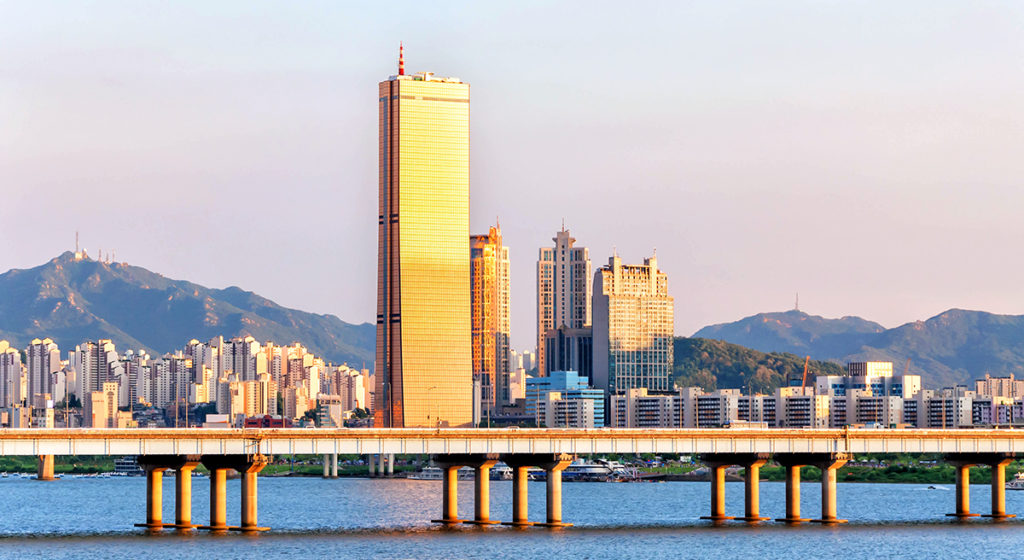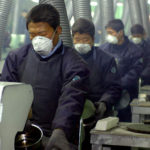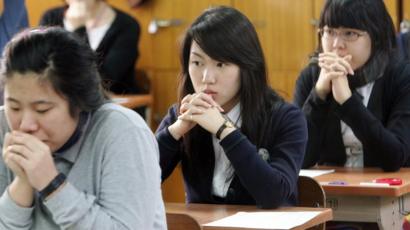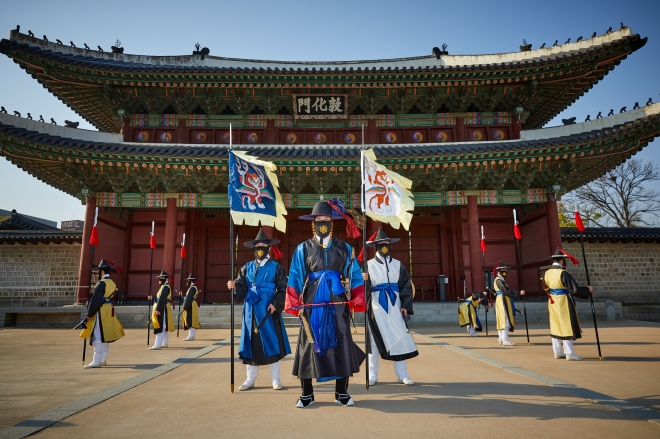I still clearly remember my daily effort to collect discarded papers, even asking my neighbors to share their paper trash.
Every week in elementary school, I was forced to collect discarded papers and deposit them to several big trucks parked in the school’s playground. When I handed the bundles of paper that I had collected to the ahjussis — old men — who were standing on top of piles of discarded papers, they weighed my contribution and rewarded me with one paper ticket for every two kilos of paper I had collected. I would then submit these tickets to my homeroom teacher who would commend me for my devotion to the environment, or to the Korean economy.
I learned that these tickets were symbols of my economic contribution as a Korean citizen. It was my first experience of collective action to boost my country’s economy.

Koreans lining up to donate their own gold as a collective action to overcome their country’s financial crisis. (kocis.go.kr)
This idea that the collective effort of individuals underpins the Korean economy is still prevalent in Korea.
My generation of Koreans grow up learning that our collective effort to overcome the country’s economic crisis back in 1997 is our greatest national pride. The middle-class was not at all hesitant to donate their gold and foreign currencies for the country to overcome its scarcity of foreign exchanges, mainly US dollar deficiency. It has created the perception that all future economic challenges can be met with the same dogged determination.
However, several economic indicators warn that this may not be the case today. Sadly, and somewhat alarming, we must admit that Korea will not experience such a communal experience of rejuvenating the economy again. South Korea today is facing vastly different challenges than those of the Asian Financial Crisis.
Inside Pressure: Daydream of Income-led Growth
When President Moon Jae-in took office, he put job creation first on his agenda and stressed on income-led growth. This growth policy was founded on the hope that economic inequality could be solved based on increase in income, and all South Korean individuals could play more economic roles. One of the areas where this commitment was well reflected, was the rapid increase in minimum wage.
South Korean minimum wage drastically increased by 16.4 percent in 2018 and 10.9 in 2019. However, because of its labor structure, the South Korean economy is not stable enough to endure such a sharp increase in labor costs. According to the National Assembly Budget Office (NABO), the number of self-employed South Koreans was 5.57 million or 21 percent of total employment in the first quarter of 2017.
Since most self-employed South Koreans are a part of the consumer staples market, it’s hard for their businesses to see success. This is the reason why it is not regarded as a good sign for its economy. This labor structure, from the start, cannot grow beyond some extent unless people begin to spend more. But the current economic status does not allow for free spending. Moon’s fundamentally good intention to boost the economy by making people spend more with increased incomes, in fact worsened employment. This made it harder for people to find employment, even on a part-time minimum wage basis.
Even this dramatic increase in minimum wage ceased this year. The number increased by only 2.9 percent setting Korea’s 2020 minimum wage to 8,590 won (7.29 USD). Small business owners requested the government to at least lower minimum wages for foreigners, but to no avail. The average increase rate of minimum wage during the Moon government for the past three years is 10.06 percent, and this number is higher than his predecessors.

President Moon Jae-in speaks at a New Year press conference at Cheong Wa Dae on Thursday. (Yonhap)
Even with this whopping increase, it is far from Moon’s presidential election pledge to reach 10,000 won (8.44 USD) during his term. Even Moon, himself, admitted that the policy is hard to achieve, saying, “As the president, it is very regrettable and I am sorry for failing to keep my promise to the people.”
The increase in minimum wage was especially hard on convenience store shop owners and part-time workers. To cover a dramatically increased minimum wage, shop owners must work longer hours and part-time workers lost their workplace since employers were not ready to pay for higher minimum wages but had to layoff their staff. Of course, Moon should not be the only one to be blamed for his unattainable goal. One authority from the ruling party even confessed to Kyunghyang, a newspaper that they neglected the “proper amount of minimum wage increase, its decision-making system, and the range of people affected,” when approaching the wage increase. The government and ruling party were looking for conspicuous means to prove their economic success and the minimum wage was one of those surest economic growth indications.
As a country, probably working the hardest and longest in the world, income-led growth is a dream for Korean citizens, not just for the government. The citizen’s initial high approval ratings in response reflects this expectation. However, this policy was too dependent on domestic growth led by consumer spending while the country is heavily dependent on trade with other countries such as the U.S. and China.
Outside Pressure: Decrease in Benchmark Interest Rate
The minimum wage issue is domestic, but the recent decrease in benchmark interest by the Bank of Korea (BOK) is negatively reflecting international financial situations. The BOK recently decided to keep its lowest benchmark interest rate of 1.25 percent at the last meeting in 2019. Governor Lee Ju-yeol told a news conference that “the (local) economy will continue to show a trend similar to the current pace until the middle of next year and then will likely begin improving.” It is meaningful because the BOK has been reluctant to lower its benchmark interest rate since 2016 out of fear that foreign investors will leave the South Korean financial market.
The BOK cut the policy rate by 25 basis points in two previous meetings in July and October of 2019. In July, the BOK cut its benchmark interest rate from 1.75 percent to 1.5 percent. The decision was made due to looming pressure on the Korean economy from the outside. Noh Dong-kil, an analyst at NH Investment & Securities told Korea Joong Ang Daily that the BOK’s decision did not come out of the blue, but the BOK seemed to worry more about “Japan’s move to remove Korea from its ‘white list’ and the stalled negotiations between the United States and China over trade.” The situation became worse in October with one more decrease in the BOK’s benchmark interest rate from 1.5 percent to 1.25.
The BOK’s decision has been dependent on the US Federal Reserve (Fed)’s decisions on its benchmark interest rate. During the last three years, the Fed increased its benchmark interest rate after performing quantitative easing. The Fed recently decided to keep its wait-and-see policy by lowering its benchmark interest rate to a range of 1.5 percent to 1.75 percent in November, 2019. The BOK board’s recent decision was also affected by this recent policy of the Fed. The BOK said in its press release after their November meeting that their future decisions include “carefully monitoring developments in the US-China trade negotiations” and “the economies and monetary policies of major countries.” As Noh pointed out, the BOK’s decision was more of “weakening economic indicators,” while “a planned rate cut in the United States is more of a pre-emptive measure.”

The Han River in Seoul today.
Fear of ‘R’ but…
Along with the gloomy forecast of “less than two percent” economic growth, many people worry that the South Korean benchmark interest rate being lower than that of the U.S. could bring about an economic recession, or “fear of R” — fear of economic recession/ crisis — as coined by Koreans. To find out whether this long-term indicator (benchmark interest rate) works or not will take time. Meanwhile, the BOK forecasted in November 2019 that South Korean economic conditions will improve in the next two years, with a consumer price inflation of 1.0 percent and 1.3 percent.
Looking back, my generation grew up with the communal pride of overcoming economic recession. But now, the Korean economy is suffering from many inside and outside threats that Korean people cannot counter no matter how much papers or gold we collect. We tried to follow in the footsteps of our parents’ and teachers’ generations who enjoyed the golden era of Korean economy boom. Their generations not only easily gained employment and purchased houses, but proved that the economy could be improved through their collective action. However, by the time my generation graduated from college, finding a decent job became difficult, and buying a house in Seoul became akin to buying a unicorn.
If the Korean economy stays gloomy, what lessons will my generation pass on to the next? The only thing we learned was ‘we can overcome this together.’ Can my generation also exert collective actions to revive our economy? Probably no. South Korea has already exerted its own growth engines and been dependent on foregin trades largely. Young generations have been busy blaming themselves for not being competent human forces the society is looking for and only to try had finding stable jobs. The idea of sticking together just remains as a fairy tale to them. But they have to be reminded that those stable jobs they are expecting cannot be created without treating these economic wounds we already have.







2 Comments
우리가 취업할 수 있을까? - Novasia
5 years ago[…] 자리 하나 구하는 것도 취업만큼이나 어려운 일이 된 것이다. 지난 가을에 NOVAsia에 쓴 글에서 한국 경제를 힘들게 하는 많은 요인 중 하나로 급격한 최저임금 […]
Will We be Hired? (우리가 취업할 수 있을까?) - Novasia
5 years ago[…] 자리 하나 구하는 것도 취업만큼이나 어려운 일이 된 것이다. 지난 가을에 NOVAsia에 쓴 글에서 한국 경제를 힘들게 하는 많은 요인 중 하나로 급격한 최저임금 […]
Comments are closed.